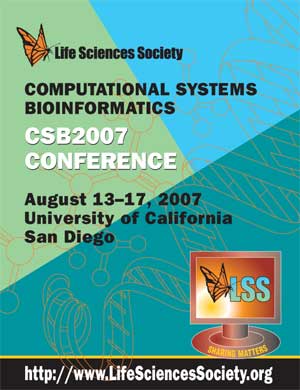An Algorithmic Approach to Automated High-Throughput Identification of Disulfide Connectivity in Proteins Using Tandem Mass Spectrometry
Timothy Lee, Rahul Singh*, Ten-Yang Yen, Bruce Macher
Department of Computer Science, San Francisco State University, 1600 Holloway Avenue, San Francisco, CA 94132-4025, USA. rsingh@cs.sfsu.edu
Proc LSS Comput Syst Bioinform Conf. August, 2007. Vol. 6, p. 41-51. Full-Text PDF
*To whom correspondence should be addressed.

Knowledge of the pattern of disulfide linkages in a protein leads to a better understanding of its tertiary structure and biological function. At the state-of-the-art, liquid chromatography/electrospray ionization-tandem mass spectrometry (LC/ESI-MS/MS) can produce spectra of the peptides in a protein that are putatively joined by a disulfide bond. In this setting, efficient algorithms are required for matching the theoretical mass spaces of all possible bonded peptide fragments to the experimentally derived spectra to determine the number and location of the disulfide bonds. The algorithmic solution must also account for issues associated with interpreting experimental data from mass spectrometry, such as noise, isotopic variation, neutral loss, and charge state uncertainty. In this paper, we propose a algorithmic approach to high-throughput disulfide bond identification using data from mass spectrometry, that addresses all the aforementioned issues in a unified framework. The complexity of the proposed solution is of the order of the input spectra. The efficacy and efficiency of the method was validated using experimental data derived from proteins with with diverse disulfide linkage patterns.
[CSB2007 Conference Home Page]....[CSB2007 Online Proceedings]....[Life Sciences Society Home Page]